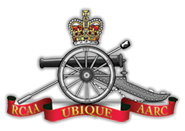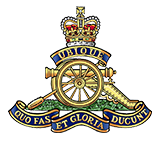Operations Other Than War Since 1945
Since World War 2, members of The Royal Regiment of Canadian Artillery have served on some 33 deployments and missions for operations other than war. Gunners have served in places such as the Congo, Egypt, the Golan Heights, Hanoi, Saigon, Laos, Iran, Iraq, Namibia, South Africa, Central America, Somalia, Haiti, Rwanda and Mozambique to name a few. The Regiment has deployed units and batteries on operations other than war, both in an infantry role and with their guns, many times. Some of the more significant commitments are discussed in the following paragraphs. As of 2011, three members of The Regiment had been killed on these deployments.
Canada deployed a battalion-sized peacekeeping force in an infantry role as part of the UN mission on Cyprus continuously from 1964 until 1993. Some 33,000 Canadians served on this mission. Over the decades, U, X and W Bty deployed to Cyprus as companies in other units. In 1974, 1 Canadian Airborne Battery, RCA was deployed from Canada with 81mm mortars to reinforce the Canadian Airborne Regiment during a major Turkish Army offensive on the island. The Battery did not have to fight, but this was the closest that Canadian Gunners had come to war since Korea. 3 RCHA completed a tour as a unit 1982-83, as did 2 RCHA 1985-86. 5 RALC completed a unit tour 1987-88. 1 RCHA served 1991-92 and 2 RCHA was the last Canadian contingent on its second tour in 1993.
More aggressive efforts to contain fighting became known as “peacemaking” in the early 1990’s to distinguish them from the more passive “peacekeeping”. At the end of the Cold War, with no other significant threat perceived, the Army began to focus on peacekeeping / peacemaking as the likely way ahead. Cold War tensions had “kept a lid on” many regional conflicts due to the moderation of the superpowers who were concerned that regional wars could spark a global confrontation. With the demise of the Soviet Union and most communist dictatorships, there was a sharp increase in small wars around the globe. In particular, the eruption of civil wars in the former Yugoslavia would have a significant impact on The Royal Regiment.
Gunners from X Bie, 5 RALC deployed to the former Yugoslavia in 1993, providing a Mortar Troop, FSCC and observers for the Canadian Battlegroup. They were followed in this role by Gunners from 1 RCHA, who fired an 81mm illumination round over the heads of factions involved in a firefight as a deterrent on 3 July 1994. This was the first operational round fired by Canadian Gunners since the Korean War. The mortar task continued with further rotations from 1 RCHA, 2 RCHA and 5 RALC Gunners into 1999.
In 1999, 1 RCHA deployed C Bty as an infantry company and A Bty deployed as a gun battery equipped with the LG1 105mm howitzer towed by modified Grizzly APCs. This set the pattern for subsequent deployments by all three Regiments until 2002, when 5 RALC deployed Q and R Bie in those roles for the last time. Thereafter, only BC and FOO parties were deployed until the rotations stopped in 2004. The drawdown of the Gunner commitment to the former Yugoslavia was necessary in order to meet the new demands of the War in Afghanistan.
Canadian Gunners have been also called upon on numerous occasions since the earliest days of The Regiment to assist Canadians in disasters and to aid the government in maintaining order and security (Aid to the Civil Power). In recent years, 5 RALC and W Battery were deployed with guns near Montreal during the First Nations uprising known as the Oka Crisis. Elements of the 4th AD Regiment also participated in the deployment. In the spring of 1997, all Regular artillery regiments and 26th Fd Regt were involved in the flood fighting in Manitoba. In January 1998 The Regiment provided aid in the aftermath of the Century’s worst ice storm in Ontario and Quebec. In 2002, The Regiment deployed numerous soldiers to provide security for the G8 Summit. Gunners deployed in 2010 as part of the security force for the Vancouver Olympics.
Since 1962, Gunners have been involved in avalanche control duties at Roger’s Pass, British Columbia. Under an agreement between the Department of National Defence and Parks Canada, The Regiment (normally by drawing on the unit stationed at Shilo, but also employing Reserve Gunners and other units when the Shilo Gunners are not available) furnishes a detachment commanded by a junior officer with one or two 105mm howitzers to carry out counter-avalanche firing from 1 December to 1 April each year. Because of the isolated nature of their task, detachments are normally rotated at six-week intervals. Firing takes place from a number of permanent surveyed-in positions, and shoots are programmed based on snow build-up analysis by Avalanche Control officials. High explosive rounds are fired at critical trigger points along 27 miles of highway in Glacier National Park in order to bring down snow build-up before it can cause a major avalanche.


